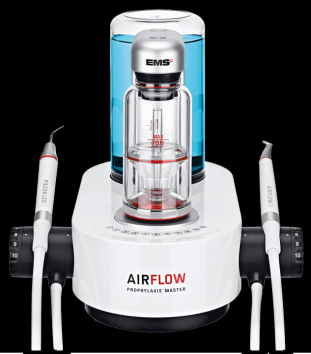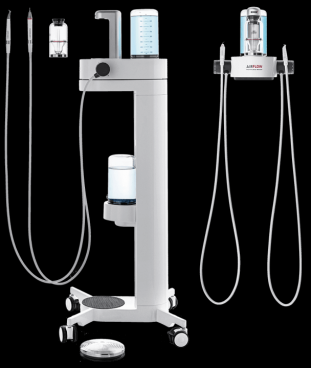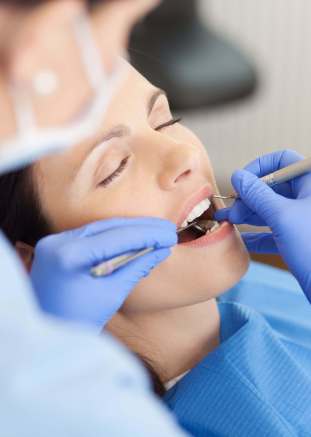Reception: ![]() +36/30 show
+36/30 show
6721 Szeged, Osztrovszky utca 12.
Open every week-day since 1996
Open on week-days from 8 AM to 9 PM
24 578 satisfied customers
Serving you since 1996
The best way to prevent dental problems is to practice good oral hygiene and to visit your dentist regularly. By having your teeth checked at least once every six months, you minimise the risk of a major dental problem developing because your dentist can closely monitor the health condition of your teeth. It is also a good idea to have your teeth cleaned professionally by a dental hygienist every time you have a regular dental check-up. This oral hygiene treatment will not only improve the aesthetic appeal of your teeth; it will also protect you against a whole range of dental diseases.
Compared to traditional procedures of dental biofilm removal, the EMS professional dental hygienic device is not only capable of removing the visible, yellow-white coloured plaque stains that stick firmly to the surface of the tooth, but as well the white or transparent-coloured biofilm that remains generally invisible. This is called the Guided Biofilm Therapy (GBT).
Plaque is a thin film-like substance forming on the surface of your teeth that consists of bacte-ria. Plaque formation is an almost inevitable consequence of eating. How strongly plaque can adhere to your teeth will greatly depend on the unique bacterial flora of your mouth and your tooth brushing habits. Removing this deposit from your teeth takes regular and thorough brushing, but, unfortunately, brushing does not completely remove all plaque.
Plaque is often visible to the naked eye, and occasionally it can build up under your gum line. As it builds up layer after layer, plaque interacts with the calcium in your saliva, creating tartar, which provides an ideal environment for various bacteria that produce substances damaging the gum and, over time, the periodontium. Normally, your gum adheres tightly to your teeth, but over time, or as a result of certain diseases, this may change and a gap may form between your tooth and your gum. The plaque building up in this gap may then cause inflammation.
Oral hygiene treatment once every six months is an important part of a healthy lifestyle. Call our dentistry in downtown Szeged at +36 30 206 9532 for an appointment for complex oral hy-giene treatment! We look forward to seeing you soon!
vissza a kérdésekhez
Acting in combination with any accumulated plaque, certain foods and beverages may stain your teeth, creating a yellowish-brownish layer on them. There is simply no home solution to remove this layer, however thoroughly you may brush your teeth.
Stains may be caused by the following factors:
Oral hygiene treatment once every six months is an important part of a healthy lifestyle. Call our dentistry in downtown Szeged at +36 30 206 9532 for an appointment for complex oral hy-giene treatment! We look forward to seeing you soon!
vissza a kérdésekhez
Tartar or calculus is calcified, hardened dental plaque. Tartar damages your teeth as well as your gum because over time it leads to tooth decay and gingivitis, an inflammation of the soft gum tissue. As a result, your healthy pink gum turns red, sore, and swollen. Do your gums bleed spontaneously or when you brush your teeth? This is a typical symptom of gingivitis. In extreme cases, and in susceptible patients, gingivitis may lead to periodontitis.
If you do not have your tartar removed regularly and your gums are in a constant state of in-flammation, your gums will start to recede, become thin and atrophied. This inflammation gradually spreads along the roots of your teeth to your jaw bones, which may lead to the fol-lowing severe consequences:
There are no home remedies for removing plaque, stains, or tartar. You can keep your teeth healthy by seeing us once every six months to have your plaque, stains, and tartar removed. This involves a 30 to 40 minute pain-free oral hygiene treatment performed by a clinical dental hygienist or by a dentist. Sometimes a thorough dental hygiene treatment that gives your teeth back their original colour works as well as teeth whitening.
Call Dentha Dentistry Szeged at +36 30 206 9532 for an appointment and experience the benefits of a complex oral hygiene treatment!
vissza a kérdésekhezBiofilm – or in other words the dental plaque or tartar – is a layer on the teeth, implants, crowns and dental braces that is not visible for the naked eyes. The biofilm itself is produced by many different bacterial strains among which can be found microorganisms of natural impact but also bacteries that are favoring the development of dental caries and gum infections.
Thus, it is very important to remove the biofilm, for its continuous development increases the amount of bacterial strains favoring the apparition of dental caries, gum infections, periodontitis and other type of infections around the dental implants. By regularly removing the biofilm, we can considerably extend the longevity of our teeth, implants and crowns (dentures).
In our clinic, as a new service, we propose a Guided Biofilm Therapy (GBT) executed by EMS’s Airflow Prophylaxis Master device. By using the special disclosing marker of the system, we make the biofilm on the teeth visible and its removal much more effective. During the disclosing procedure, the different colour-depths are referring to the age of the plaque-layer, whether it is a young or old biofilm. By using this therapy, we remove not only the paint, but with it the biofilm as well.
vissza a kérdésekhezThe EMS’ Airflow Prophylaxis Master ensures the most updated, ultramodern oral hygiene therapy. This is a complex dentalhygienic system for removing dental plaque, tartar and stains (using one word: the biofilm) and also for polishing and whitening1 your teeth, all this almost painlessly. The therapy is gentle and precise, it doesn’t hurt the enamel and removes the dental plaque from everywhere.
Often, the traditional dental plaque removal is a painful procedure and it is of much weaker efficiency.
*doesn’t replace the tooth whitening
vissza a kérdésekhez

„I’ve been always afraid of the traditional way of dental plaque removal, several times the ultrasound plaque removal device caused pain. Instead, my EMS Guided Biofilm Therapy was perfectly painless, only the airflow coming from the hand-device kept on cooling my teeth. So, all in all, I went through much less stress and discomfort-feeling, than earlier. The other adventage of this procedure was the dental plaque disclosing method. It was very impressive to see with my own eyes, in which areas should I improve my toothbrushing technics.”
vissza a kérdésekhez
- how to choose the right tooth brush;
- what is the right technique to brush your teeth;
- how to use dental floss;
- whether an interdental brush should be used or not;
- why it is a good idea to also use a tongue cleaner; and
- how often you should use mouthwash.
Why is it a good idea to visit your dentist regularly for oral hygiene treatment?
Oral hygiene treatment once every six months is an important part of a healthy lifestyle. Call our dentistry in downtown Szeged at +36 30 206 9532 for an appointment for complex oral hy-giene treatment! We look forward to seeing you soon!
vissza a kérdésekhez